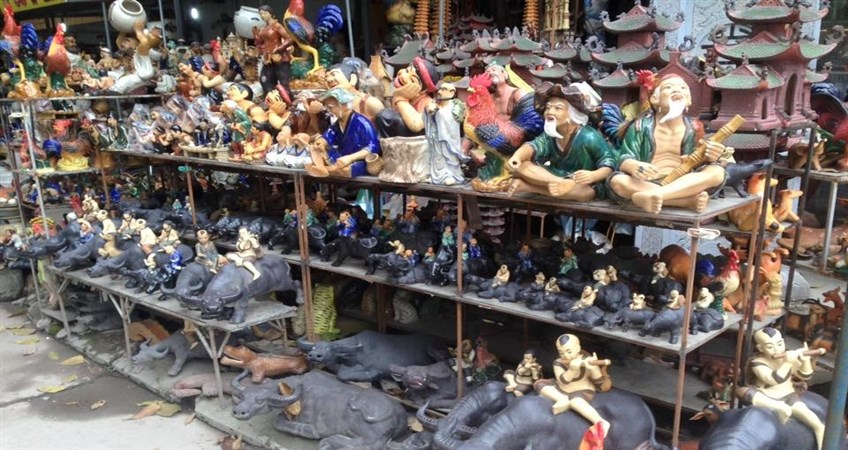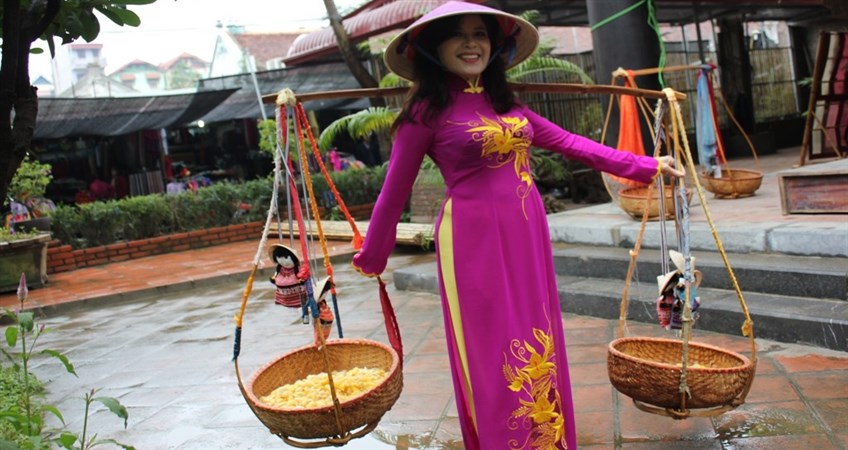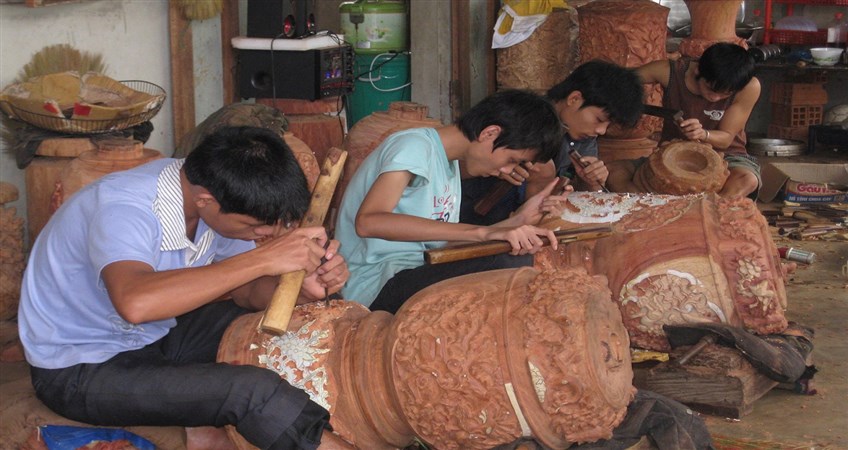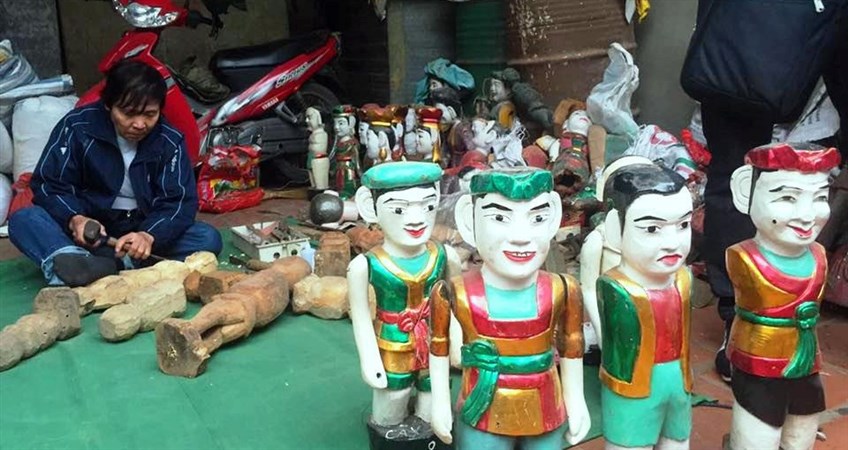Bat Trang Ceramic Village
Bat Trang has been making ceramics for seven centuries and as a result has become a village that tourists enjoying a Vietnam holiday and spending some time in its capital, Hanoi, can visit on a trip arranged by a Hanoi travel agent even if it is not included in the overall Vietnam travel package. It is less than half an hour away from the centre of Hanoi so it is a village not to be missed.
The reason why ceramic manufacture was possible is the ready availability of clay. The village is next to the Red River between two towns that developed as trading centres between the 15th and 17th Centuries, Thang Long and Pho Hien. Its ceramics had a strong domestic market but trade opened up with the Japanese, Chinese and European traders becoming regular customers.
During the Nguyen Dynasty, trading restrictions were put in place so there was minimal export. Times were hard in Bat Trang Village. However in modern times, especially since the Government of unified Vietnam has recognised the value of contact with the rest of the world, east and west, Bat Trang’s ceramics have become popular once more.
Bat Trang’s skilled craftsmen produce all kinds of things; everything household but much more. Even the household products have become things of beauty. Visitors to the village can walk around or join a buffalo tour and visit the shops as they go. They can watch the ceramics being made during their time in the village. There are many small items that they can buy as presents for friends and family without adding too much weight to their luggage.
It is a great experience visiting the villages in the north; life has changed little over generations and it is a real experience to be able to observe that at first hand.

Dong Ho Painting Village
This village on the left bank of the Duong River has been known for its painting for centuries. Back in the 1950s there were still as many as 100 families involved in painting but that number has diminished fairly significantly. These days there is more to the village than painting with many families having switched to making joss paper.
If you are on a Vietnam holiday and spending time in Hanoi then a trip to Dong Ho is certainly something to consider. A Vietnam travel agent will be able to make any arrangements.
Once there, you should visit two families, those of Nguyen Dang Che and Nguyen Huu Sam. Both have galleries and provide work for others and are clearly determined that the tradition of painting will not die.
The paintings reflect everyday life within the village as well as things that the villagers hope for. Animals are a common subject, likewise things like Market Day or the traditional folk stories of the village. They paint on paper made from the bark of a tree. It means that the paint is absorbed and lasts longer than it would otherwise do.
Inevitably the styles change from family to family. Molds are used to stamp to build up the picture and its colour. It is a fairly simple process and there is nothing complex about the image that is created. It is the meaning of the painting that is significant and you will get a chance to ask about this when you visit the village.
These days, the range of pictures that are being produced has expanded and provide an excellent souvenir of your Vietnam tour. If you have a few spare hours then this village is certainly a place to consider, especially if you have a real interest in art.

Van Phuc Silk Village
There are many highlights in a Vietnam holiday and one of them is certainly learning more about local life. Every Vietnam travel package is likely to involve time in the capital, Hanoi, and the street activities of food stalls and markets are great fun. However, as soon as you get out of the City, you are in rural countryside where farmers work hard in the fields. There are villages that also have other skills than growing rice and vegetables. A good Hanoi travel agency will offer the chance to visit some of them. One that is just 10 km to the south west of Hanoi’s Old Quarter is Van Phuc.
It is a village famous for its traditional methods of weaving and the quality silk products it produces make great mementoes of Vietnam travel and make great presents for friends and family.
The Village sits on the bank of the Nhue River where there has been a settlement for over 1,200 years. Van Phuc is typical of villages in North Vietnam with the centre of the village being the communal house and the usual Banyan tree. There is also the continuous sound of the looms that produce a wide range of silk products, shirts and ties, dresses and various crafts.
In former times, silk was regarded as very precious and it was only really royalty and aristocrats who could afford to wear it. During the Nguyen Dynasty that began at the start of the 19th Century, Van Phuc silk was taken down to the then capital, Hue in central Vietnam. The French were colonial rulers for many years and this silk was exhibited in both Marseilles and Paris in the 1930s. Once the French left and North Vietnam became an independent communist country, the biggest market for Van Phuc silk became Eastern Europe but these days its market is truly international.
It is typically lightweight, smooth and elegant. It ensures clothes are cool in the summer and warm in the winter. There are silk shops lining the main street in the village and the naturally friendly villagers are delighted that the growth of international tourism year on year is bringing more customers to their doors.
There are still some traditional looms in houses but the industry is increasingly mechanised with power looms that are much quicker. Visitors will still be able to see how the silk was woven with manual looms.

Chuong Conical Hat Village
Many of the images of Vietnamese villagers and city street traders that you see will have then wearing a hat; they are great as protection from the hot sun. Conical hats are very popular and there is a village close to Vietnam’s capital, Hanoi that specialises in making these hats. Chuong is a place that you can visit during a Vietnam holiday. Many Vietnam travel packages include Hanoi and there is no reason why trips out from the City to places like Chuong should not be included in your itinerary.
The village began making these hats three centuries ago although the origins are a little unclear. There is a traditional folk song that contains the line: “Whoever wants a beautiful conical hat can come to Chuong village”.
The hat may look simple but it takes time and patience to make a single hat. The raw material used is green palm leaves brought to Chuong from Quang Binh and Phu Tho Provinces. They are left in the sun to dry, turning white as the moisture disappears. Once they are completely dry, the leaves are ironed to harden and flatten them.
The leaves are then put on a wooden frame and sewn together with silk thread. The hats from the village are instantly recognisable because no other hats use 16 rounds of needling. The final process is to coat the hat with oil so that the leaves do not go mouldy.
If you go to Chuong on one of the 6 days in each lunar month when the hats are traded, you can observe the activity though it’s an early start, 6 pm with trading lasting for only a couple of hours. They are great as souvenirs of Vietnam travel.
Many people in the village can make these hats and of course they also grow their own food; Cuong is a busy place.

Dong Ky Wood Carving Village
North-east of Hanoi in Bac Ninh Province is the village of Dong Ky. A Hanoi travel agent will be happy to arrange a visit during your Vietnam holiday. The village has a tradition of wood carving, items ranging from furniture to decorative carving on wood. Dong Ky produces everything a family might need; beds, cabinets and gates are just three examples.
Dong Ky is certainly a wealthy village and there are claims that it is among the richest in Vietnam though in former times the villagers found it difficult to grow enough food to eat. Their answer was to find something else to do with their time and carving was the answer. The products are sold throughout the region, and of course down in Hanoi.
It is a real experience watching these skilled craftsmen at work. The village is just a short distance from Hanoi that may be where you are making your base in your Vietnam travel itinerary.
Over the last forty years or so, the demand for antique furniture has been growing and Dong Ky was not slow in making modern versions of the limited supply of such furniture. It was acknowledged as replica but it still demanded a high price because of the artistry involved in its manufacture. You will see many examples of the delicate touch that these carvers have, with the birds, mammals and flowers especially attractive.
One of the real experiences that you can get during a Vietnam holiday is meeting the people. That may be the street vendors in the cities, hill tribes or fishermen. There is no doubt that it is also in the craft villages surrounding Hanoi, and Dong Ky carving village certainly deserves its place in the list of short tours for overseas visitors to take.

Phu Lang Pottery Village
Phu Lang has become a well-known brand in pottery and even though there are fewer families in the village now involved in producing pottery, the tradition of producing and the wonderful environment within which they work are unchanged. It is certainly worth asking your Vietnam travel agent to devise a Vietnam travel package that includes visits to villages where life has changed little over generations.
Phu Lang is one such village; it sits below a small range of hills on the Cau River. This is Que Vo District in Bac Ninh Province, a province well-known for its temples and pagodas. Hanoi is just 60 kms away to the south-west. Hanoi is an excellent base for exploring the whole of the region and that very much includes the village communities.
It is thought that the tradition of making pottery in Phu Lang dates back many centuries and it was certainly thriving in the 17th Century during the Tran Dynasty and there are many samples of that work in the Vietnam History Museum.
A family involved in pottery will have a yard full of firewood and the raw clay for which the area is famous. Everyday domestic products are made; vases, teapots, jars etc. some are highly decorated, others simply employ the rich brown colour of the clay. Perhaps its most famous product is also its most profitable; ceramic burial caskets? They are too big to put in your suitcase.
The villagers will happy show you how pottery is made and are clearly happy if you select a piece to a souvenir of your Vietnam holiday. Some of the kilns they use are tunnel-shaped and up to 20 metres long. They take great pride in their skill and the things that they produce, even those that are in daily use within the village.

Chang Son Wooden Fan-making Village
Fans are mass-produced these days but there is no real replacement, certainly not as a tourist souvenir, than the wooden fans that have been made in Chang Son village near Hanoi for generations. It is vital that the traditional skills of the region survive and one of the main reasons why they are likely to is the fact that tourism is on the increase and Vietnam travel packages are being designed to ensure that visitors have the chance to mix with the locals. That is especially available around Hanoi where villagers have been both farmers and craftsmen for many generations.
The village is typical of many you will see in Vietnam; the banyan tree and communal house, the pagoda and the surrounding rice fields.
In Chang Son, the fans are made by hand. If you get a Hanoi travel agent to organize a trip, you will see how the villagers make their fans. Modern technology may be more efficient but it cannot replace tradition and culture.
The fans come in many sizes. Some are much bigger than an individual would use to keep himself or herself cool in humid weather. Most homes will have one of Chang Son’s huge fans hanging on their walls for decoration. The colours are bright and designs often intricate. Different villagers have different skills and several people may contribute their skill to a single fan. While some members of the family are working in the fields there may be at least one helping to produce the fans for which the village has become famous. The number of tourists choosing to visit makes it a very worthwhile economic enterprise.
If you visit Chang Son, there is a good chance that you will see something that settles one of your needs for souvenirs or present, the lovely fans.

Quat Dong Embroidery Village
The craft villages of North Vietnam have become an important part of a Vietnam holiday. Hanoi is a logical starting point for a Vietnam tour package with a visa to Vietnam available at the airport of Vietnam’s capital. The contrast between the bustle of Hanoi and the surrounding rural areas is quite marked. Many locals are farmers but equally there are villages that have become well known for a particular skill. In the case of Quat Dong, it is embroidery.
It is a craft from many centuries ago. Stories tell how the royal concubine, Y Lan taught embroidery to the maids in the palace of the Ly Court in the 11th Century. However it was six centuries later before it really became popular. A man from Quat Dong, Le Cong Hanh learnt about embroidery while serving as an envoy in China and his return home signaled the start of embroidery in his village. He is regarded as the Ancestor of Quat Dong Embroidery.
The village’s products soon became popular in the Court and Quat Dong retains its reputation even though the skill has spread countrywide.
It is a very good day trip out of Hanoi that a local travel agent will arrange for you if you are staying in the city. As you approach the village, you will see flashes of colour, shops with windows full of intricate embroidery. Within the village, you will see the banyan tree and the 200 year old temple that honours Le Cong Hanh; the anniversary of his death in the 2nd Lunar Month is a special day in Quat Dong.
If you are looking for souvenirs of your Vietnam travel then the landscape embroidery from Quat Dong surely deserves serious consideration? The more complex ones will have taken a great deal of time to complete.

Dao Thuc Water Puppetry Village
Water puppetry has been a popular form of local entertainment for 300 years. The village is on the outskirts of Hanoi where many Vietnam travel packages begin. Once spring starts, performances receive large audiences and overseas visitors on a Vietnam holiday are more than welcome. A Hanoi travel agency will be more than happy to help with the arrangements if you need it.
Legend has it that a man from the village, Dao Dang Vinh became passionate about water puppetry in the 18th Century and resolved to ensure it was a skill that would be handed down through future generations. There is a stone memorial to him that was erected in 1735. On the anniversary of his death, the 2nd lunar month, 24th day, the villagers remember him by lighting incense.
The puppets vary in size between 30 and 40 cms., made in wood then painted. The villagers of Dao Thuc make them themselves. Each puppet is a famous person from traditional Vietnamese folk stories. There are some 20 stories involving everyday activities in the region; planting and ploughing, song and dance and fishing.
One of today’s masters who has been performing for over 30 years, Dinh Huu Tu talks of watching puppetry when he was very young. It takes a good deal of practise he says with the movement of the puppet needing to be in time with the music. Youngsters are encouraged to learn the skill in the hope that Dao Dang Vinh’s dream lives on. With the shows so popular, it is extremely likely that it will, especially since such skills are appreciated by locals and tourists alike. Dao Thuc is just 20 kilometres from the heart of Hanoi so can easily be made part of an interesting day in the city.





